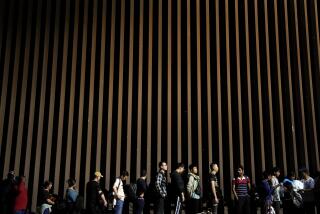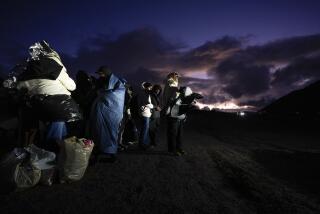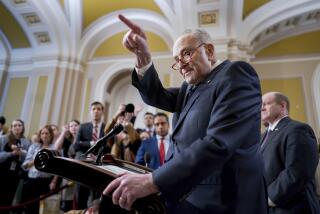U.S. Likely to Ease Security for Mexicans Making Brief Visits
WASHINGTON — Millions of Mexican citizens who make brief visits to the United States are likely to be exempted from requirements that they be fingerprinted and photographed, the Homeland Security Department said Thursday.
The plan, which applies to 6.8 million holders of a special U.S. border-crossing card, was viewed as a gesture to Mexican President Vicente Fox on the eve of his visit to President Bush’s family ranch in Texas.
Mexico has complained that requiring its citizens to submit to the new fingerprinting program, known as US-VISIT, is discriminatory. Canadian visitors are not required to undergo such checks.
Asa Hutchinson, the Homeland Security undersecretary responsible for monitoring the border, told the House Government Reform Committee that the changes were under consideration and that final details had not been worked out.
In prepared testimony that was circulated to Congress but not delivered at the hearing, Hutchinson described the plan as ready to take effect. Aides said he withdrew the testimony because some technical issues remained unresolved.
Some lawmakers have urged the department to broaden privileges for visitors from Mexico.
Homeland Security officials said that under the plan, holders of border-crossing cards would not have to undergo fingerprinting if they intended to stay no more than 72 hours and travel within 25 miles of the border. Known as “laser visas,” the cards are popular with Mexicans who cross frequently to shop, visit family or work in the United States.
However, card holders planning longer visits or extensive travel would have to be photographed and fingerprinted.
Mexicans who are issued laser visas already have been interviewed and screened by U.S. officials; additional background checks would be redundant, said Homeland Security spokesman Brian Roehrkasse.
The US-VISIT program calls for fingerprinting and photographing all foreign visitors who are issued visas for travel to the United States.
Instituted at 115 airports and 14 seaports in January, the program is to be extended to 50 major land border crossings by the end of the year.
The system was started to provide another layer of defense against terrorism; the fingerprints are checked against federal databases.
Canadians are exempt from US-VISIT, since they do not require visas for U.S. visits of up to six months. Travelers from most European countries and some Pacific Rim nations also are exempt.
But on both sides of the U.S.-Mexico border, the program has stirred concern among political leaders and business groups, who fear it could snarl travel that is vital to the region.
Some members of Congress are sympathetic. Sen. John Cornyn (R-Texas) has introduced legislation that would grant Mexicans the same rights as Canadians.
“Mexicans visiting with laser visas invest in our real estate, own businesses and support local industry,” Cornyn said in a statement. “They have shown that they are willing to visit this country legally and should be allowed to stay as long as Canadians and engage in similar travel and commerce. It’s the right thing to do, both for our border economy and our visitors.”
Homeland Security Secretary Tom Ridge told the House Appropriations Committee that US-VISIT has resulted in the apprehension of 150 travelers with criminal records who would have otherwise gained illegal entry.
More to Read
Sign up for Essential California
The most important California stories and recommendations in your inbox every morning.
You may occasionally receive promotional content from the Los Angeles Times.










